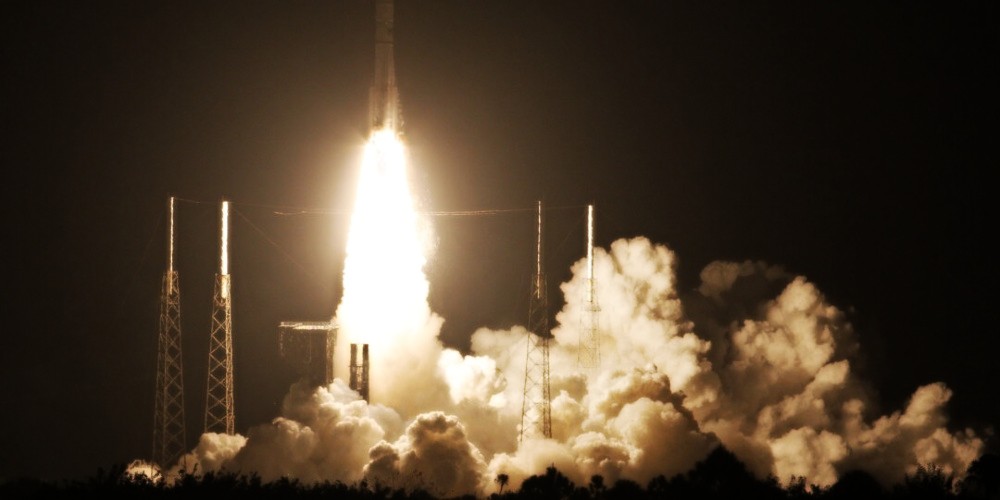(The Epoch Times)—China and Russia are populating space with dual-use satellites while concealing their military applications, according to a new report from the U.S. military.
“China and Russia view the U.S. as overly reliant upon space for military and information superiority. Seeking asymmetric advantages in future conflict, both countries are designing, testing, and demonstrating counterspace weapons to deny, disrupt, or destroy satellites and space services,” the report says. “They often mask or conceal these activities to avoid international condemnation.”
The report, titled “Competing in Space,” was jointly written by the National Space Intelligence Center, a U.S. Space Force unit, and the National Air and Space Intelligence Center, a U.S. Air Force unit.
“The dual-use nature of some spacecraft technologies makes counterspace tests or hostile activity difficult to detect, attribute, or mitigate,” the report adds. “For example, sensors to inspect other satellites and robotic arms for servicing other satellites support peaceful missions, but can also be used to target or attack spacecraft.”
A debris mitigation satellite could function as a weapon system, the report says, pointing to China’s satellite Shijian-21, which in January 2022 towed a defunct Chinese navigation satellite to a graveyard orbit.
The report named another Chinese satellite, Shijian-17, which is equipped with a giant robotic arm. “Space-based robotic arm technology could be used in a future system for grappling other satellites,” the report says.
Russia has deployed several prototype orbital anti-satellites in low Earth orbit (LEO), including Cosmos 2504, 2519, and 2536, for testing “kinetic kill capabilities,” according to the report.
Most Earth-orbiting satellites are located in LEO, which is about 1,200 miles from the surface of the Earth. Other orbits include the medium Earth orbit (MEO), the highly elliptical orbit (HEO), and the geostationary orbit (GEO). GPS satellites are located in the MEO.
Space Capabilities
The report said Chinese military exercises “regularly incorporate jammers against satellite communications” and other targets, thus making Beijing likely to have been developing jammers targeting “a wide range of satellite communications supporting government and military operations.”
Other space capabilities that China and Russia are pursuing include directed-energy weapons.
“China has multiple ground-based laser systems of varying power levels that could blind or damage satellite sensors. By the mid-to-late 2020s, Beijing may have higher-power systems capable of damaging satellites,” the report says.
In 2021, China tested a hypersonic weapon system that, according to some experts, employs a deployment method similar to the Soviet concept known as the fractional orbital bombardment system. The report said the Chinese hypersonic weaponry “could prevent reliable missile warning and complicate defense engagements.”
Since December 2018, when a previous version of the report was published, there has been a drastic increase in the number of satellites. As of the end of 2022, there were 7,096 satellites, more than triple from 1,880 six years ago, according to the report. The United States led with 4,723 satellites, while China had 647 and Russia 199. The rest of the world had 1,527 satellites.
“Over the past decade, China has rapidly developed into a major international space power, effectively multiplying its number of on-orbit satellites tenfold,” the report says. “More than half of the approximately 200 satellites China launched in 2022 were remote sensing satellites.”
- Gold SKYROCKETED during Trump’s first term and is poised to do it again. Find out how Genesis Precious Metals can help you secure your retirement with a proper self-directed IRA backed by physical precious metals.
Now, China operates more than 300 remote sensing satellites with diverse sensors, the report said, thus “improving the Chinese military’s ability to observe U.S. aircraft carriers, expeditionary strike groups and deployed air wings.”
Space Norms
Competition pitting the United States against China and Russia extends beyond Earth’s immediate orbits. Asteroids, the moon, Mars, and other celestial bodies could provide countries with valuable resources or strategic advantages, according to the report.
China is aiming to put its astronauts on the moon by 2030. Meanwhile, several nations including Venezuela, Pakistan, South Africa, and Belarus, have signed up for a planned moon base project led by China and Russia. It is officially known as the International Lunar Research Station.
The report highlighted Chinese and Russian activities at the Lagrange Points in space, including China’s Queqiao relay satellite, which is stationed at one of these five points. Due to these points’ relative distance between the Earth and the moon, spacecraft can remain in these regions for a longer period while consuming less fuel. Experts have compared these points to strategic oceanic gateways such as the Strait of Hormuz.
“These regions are uniquely valuable for long-term missions, such as surveillance, space environment monitoring, or data relay, in deep space,” the report says.
The key to the future in space is “preserving space access” for all nations, the report said, but there is a lack of international consensus on space norms.
“Despite the substantial increase in new space operators, technologies, and spacecraft, the international community has not achieved consensus on major norms, rules, or principles governing activities in space since the 1970s,” the report says.
It noted that China and Russia have endorsed a draft treaty for space that “fails to address a variety of anti-satellite weapons and lacks meaningful verification mechanisms.”
As of December 2023, 33 nations have signed up to the U.S.-led Artemis Accords, which commit signatories to a common vision of peaceful, sustainable, and transparent cooperation in space.
“The expanding utility of space systems has extended the boundaries of conflict and exacerbated the world’s vulnerability to dangers in the space environment. Actors seeking to challenge international order will have access to systems capable of devastating and lasting impacts on our progress on Earth and in space,” the report concludes.


